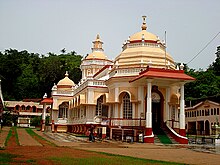
Salcete or Salcette is a subdivision of the district of South Goa, in the state of Goa, situated by the west coast of India. The Sal River and its backwaters dominate the landscape of Salcete. Historically, the sixty-six settlements south of the Zuari River formed the original Salcette territory. Salcete forms a part of the bigger Konkan region that stretches along the western shoreline of peninsular India.

Walkeshwar Temple, also known as the Baan Ganga Temple, is a temple dedicated to Lord Shiva located in Walkeshwar, near Malabar Hill neighbourhood, in South Mumbai precinct of the city of Mumbai, India. It is situated at the highest point of the city, and close to the temple lies the Banganga Tank.

The Ramnathi Temple is located in Ramnathim, Bandivade in Goa. The primary worshippers come from the social classes Goud Saraswat Brahmins (GSB) belonging to Gokarn Math, & Kashi Mutt, Daivadnya Brahmin and Vaishyas. Similar to other Goan Brahmin temples, Ramnathi too incorporates the system of Panchayatan, therefore, this temple houses 5 main deities namely; Shri Ramnath, Shanteri, Kamakshi, Laxmi Narayan, Ganapati, Betal and Kalbhairav, along with other family purushas.

Shri Shantadurga Temple is a Hindu temple, belonging to the Goud Saraswat Brahman Samaj located 30 km (19 mi) from Panaji at the foothill of Kavalem village in Ponda Taluka, Goa, India. Shrimad Swamiji of Shri Kavale Math is spiritual head Of Shree Shantadurga Saunsthan, Kavale.
Loutolim or Loutulim is a large village of South Goa district in the state of Goa, India. It is an important settlement in the Salcete sub-district.
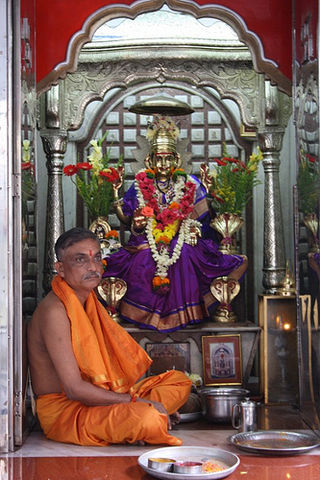
Shantadurga is the most popular form of the Hindu goddess Durga revered in Goa, India, as well some parts of Karnataka. She is a form of the ancient Mother goddess known as Santeri. She is worshipped in almost all villages of Goa & Sindhudurg district of Maharashtra as an ant hill. This is seen in some temples dedicated to Shantadurga.
Cumbarjua, is an island and town within the Mandovi River in Goa. It is situated to the east of Goa's capital Panjim at a distance of 20 kilometres. It is one of 6 major islands between the Mandovi and Zuari, he others being:

Cortalim is a village in Morumugão, Goa, India. Its native Goan population is entirely Catholic and their main occupations include fishing and agriculture. Located on the banks of the Zuari River, it was previously known as Kushasthale.

Nagueshi or Nagesh is a form of the Hindu god Shiva worshipped by Konkani Hindus in India. The temple lies in verdant surroundings in the Ponda district of Goa. Unlike many other Hindu temples of Goa which were shifted out of the Velha Conquistas the Nagueshi Temple is at its original place. It has, however, been renovated a number of times. It is located in Bandode village, Ponda, North Goa district.
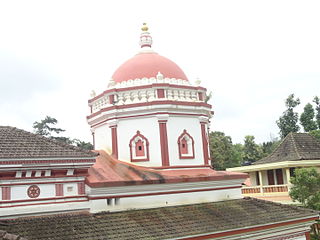
Sri Vijayadurga is a Hindu Goddess of varying importance in Indian culture and tradition. She is said to have intervened in a battle between Shiva and Vishnuthem, and gone to Shankwali to kill the demons harassing the Brahmins there. When she destroyed all the demons in sancoale she earned the name of Vijaya and was given the name as Vijayadurga. The deity is thus a form of the Goddess Durga. The Vijayadurga temple was once located in close proximity to Shri Shankleshwari Shantadurga and Shri Lakshminarsimha in Sancoale but had to be shifted to Kerim, Ponda Taluka - Goa.
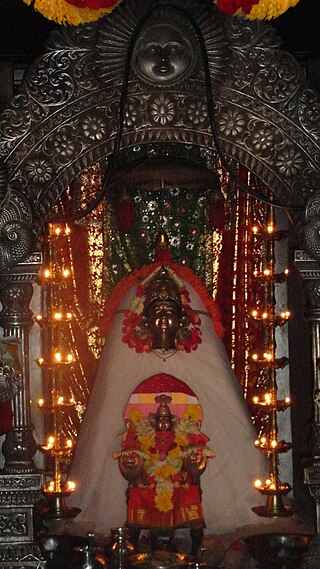
Shri Shantadurga (Kalangutkarin) Devasthan Nanora is a Hindu temple in Nanoda village, Bicholim taluka in Goa. The goddess Shantadurga is worshiped in the form of Vishweshwari.

Pondataluka is a subdivision of the district of north Goa, in the Indian state of Goa. Its administrative headquarters is the township of Ponda.

Kavale or Kavalem is a village in Ponda taluk, in the Indian state of Goa. Kavle/Kawale/Kawle are other variations for the same name.

Mangueshi is a village located within Ponda taluka in the coastal state of Goa, India. Mangueshi or Mangueshim are other variations for the same name.
Nrusinhawadi commonly known as Narsobawadi or Narsobachi Wadi is a small town in Shirol Tahasil in Kolhapur district, Maharashtra. Narsobawadi gets its name from the presence of 'Shri Nrusinha Saraswati', the Purna Avatar of Lord Dattatreya.

Shri Gaudapadacharya Math, also known as Kavaḷē maṭha, located in Kavale, Ponda, Goa, is the oldest matha of the Smarthan Saraswat Brahman Samaj. It was founded by Gauḍapāda around 740 AD, whose student was Govinda Bhagavatpada, the guru of Adi Shankara, a highly influential figure in Hinduism. There is also a belief that Gauḍapāda himself established the Shri Gaudapadacharya matha when he lived in Gomantak (Goa). Thus, the matha came to be known as Shri Saunstan Gaudapadacharya matha. Unlike other mathas, Shri Gaudapadacharya matha is not a polemical center established to influence the faith of all Hindus, its jurisdiction is limited to only Dakshinatya Saraswat Brahmins. The Peetadhipathi "head monk" is Śrī Gauḍapadācārya. Smartist Goud Saraswat Brahman Samaj and Rajapur Saraswat Brahmin are its main disciples.
Shri Katyayani Baneshwar Temple ,(Sanskrit:श्री क़ात्यायनी बाणेश्व् र मन्दिर), or the Aversa Hindu Narayani is a Hindu temple in the coastal town of Aversa near Ankola, in the Uttara Kannada district of Karnataka. It is around 100 km (62 mi) from Goa, India, 500 km (310 mi) from Bangalore and 136 km from Hubli.
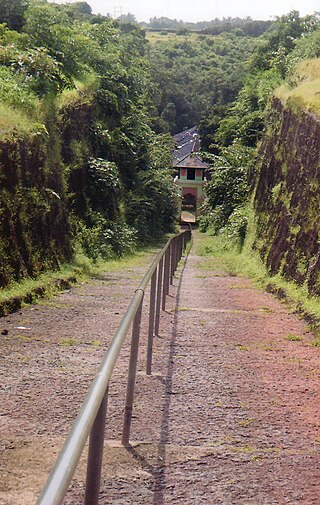
Shri Dev Rameshwar Temple is located in the village Rameshwar Wadi in Devgad taluka of Sindhudurg District, Maharashtra, India. This temple is dedicated to the Hindu deity Shiva. It is a historic temple built in the 16th century. Its chief interest is the approach about 250 yards long, cut through rock fifty feet deep. The idol, a four-armed figure seated on a bull, is made of solid silver and allegedly weighs a hundred kilograms, it is in good condition at present.

Mahalasa Narayani Temple is a Hindu temple to the goddess Mahalasa, located in Mardol, Ponda, in the Indian state of Goa.
